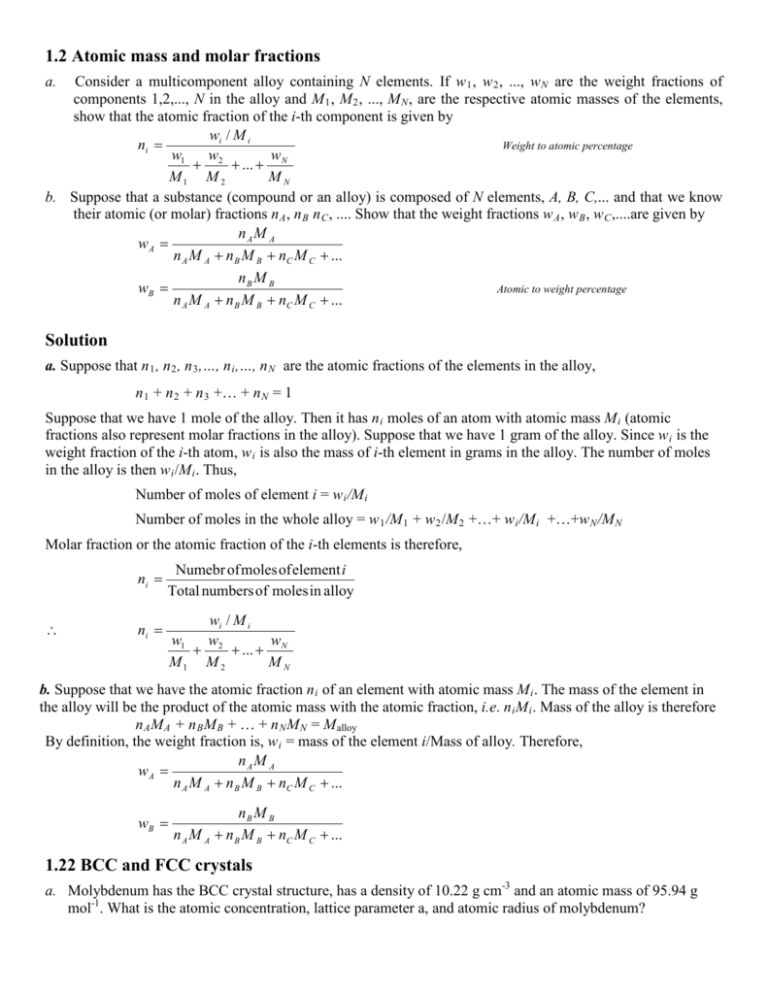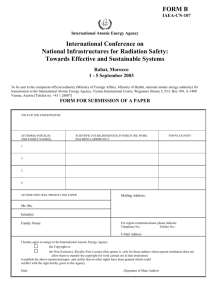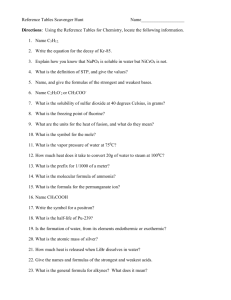1.2 Atomic mass and molar fractions Solution 1.22 BCC and FCC
advertisement

1.2 Atomic mass and molar fractions a. Consider a multicomponent alloy containing N elements. If w 1 , w 2 , ..., w N are the weight fractions of components 1,2,..., N in the alloy and M 1 , M 2 , ..., M N , are the respective atomic masses of the elements, show that the atomic fraction of the i-th component is given by wi / M i Weight to atomic percentage ni = wN w1 w2 + + ... + M1 M 2 MN b. Suppose that a substance (compound or an alloy) is composed of N elements, A, B, C,... and that we know their atomic (or molar) fractions n A , n B n C , .... Show that the weight fractions w A , w B , w C ,....are given by nAM A wA = n A M A + n B M B + nC M C + ... wB = nB M B n A M A + n B M B + nC M C + ... Atomic to weight percentage Solution a. Suppose that n 1 , n 2 , n 3 ,…, n i ,…, n N are the atomic fractions of the elements in the alloy, n 1 + n 2 + n 3 +… + n N = 1 Suppose that we have 1 mole of the alloy. Then it has n i moles of an atom with atomic mass M i (atomic fractions also represent molar fractions in the alloy). Suppose that we have 1 gram of the alloy. Since w i is the weight fraction of the i-th atom, w i is also the mass of i-th element in grams in the alloy. The number of moles in the alloy is then w i /M i . Thus, Number of moles of element i = w i /M i Number of moles in the whole alloy = w 1 /M 1 + w 2 /M 2 +…+ w i /M i +…+w N /M N Molar fraction or the atomic fraction of the i-th elements is therefore, ∴ ni = Numebr of moles of element i Total numbers of moles in alloy ni = wi / M i w w1 w + 2 + ... + N M1 M 2 MN b. Suppose that we have the atomic fraction n i of an element with atomic mass M i . The mass of the element in the alloy will be the product of the atomic mass with the atomic fraction, i.e. n i M i . Mass of the alloy is therefore n A M A + n B M B + … + n N M N = M alloy By definition, the weight fraction is, w i = mass of the element i/Mass of alloy. Therefore, nAM A wA = n A M A + n B M B + nC M C + ... wB = nB M B n A M A + n B M B + nC M C + ... 1.22 BCC and FCC crystals a. Molybdenum has the BCC crystal structure, has a density of 10.22 g cm-3 and an atomic mass of 95.94 g mol-1. What is the atomic concentration, lattice parameter a, and atomic radius of molybdenum? Solution a. Since molybdenum has BCC crystal structure, there are 2 atoms in the unit cell. The density is ρ= that is, Mass of atoms in unit cell = Volume of unit cell M 2 at N ρ = 3A a (Number of atoms in unit cell) × (Mass of one atom ) Volume of unit cell Solving for the lattice parameter a we receive a=3 ( ) 2M at 2 95.94 ×10 −3 kg mol −1 = 3.147 × 10-10 m = 0.3147 nm =3 3 23 −3 −1 10.22 ×10 kg m 6.022 ×10 mol ρNA ( )( ) The Atomic concentration is 2 atoms in a cube of volume a3, i.e. nat = 2 2 = 3 a 3.147 ×10 −10 m ( ) 3 = 6.415 × 1022 cm-3 = 6.415 × 1028 m-3 For a BCC cell, the lattice parameter a and the radius of the atom R are in the following relation (listed in Table 1.3): R= ( ) a 3 3.147 ×10 −10 m 3 = 1.363 × 10-10 m 0.1363 nm = 4 4 1.26 Zinc blende, NaCl and CsCl a. InAs is a III-V semiconductor that has the zinc blende structure with a lattice parameter of 0.606 nm. Given the atomic masses of In (114.82 g mol-1) and As (74.92 g mol-1), find the density. Solution a. For zinc blende structure there are 8 atoms per unit cell (as shown in Table 1.3). In the case of InAs, it is apparent that there are 4 In and 4 As atoms in the unit cell. The density of InAs is then ρ InAs M M 4 atIn + 4 atAs 4(M atIn + M atAs ) N N = A 3 A = = a N A a3 = ( ) m) 4(114.82 + 74.92 )× 10 −3 kg mol −1 (6.022 ×10 23 mol −1 )(0.606 ×10 −9 3 = 5.66 × 103 kg m-3 = 5.66 g cm-3






